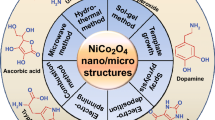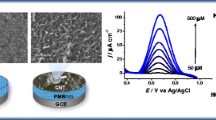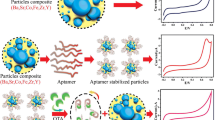Abstract
A photoelectrochemical sensing platform based on ligand-variable metal clusters charge transfer was established for the quantitative assay of ronidazole (RNZ) using Ce-porphyrin-metal–organic frameworks/silver nanowires (Ce-Por-MOFs/AgNWs). Rod-like Ce-Por-MOFs and well-dispersed sub-50 nm AgNWs were prepared using a hydrothermal method and polyol strategy, and then through simple drop coating to yield Ce-Por-MOFs/AgNWs nanocomposites. We investigated the intrinsic semiconducting properties of the composites. More importantly, it was found that the variable-valence metal node can provide electronic defect states similar to those caused by multi-metal doping, synergizing with the surface plasmon effect of AgNWs, which significantly improved the photoelectric conversion efficiency, thereby resulting in excellent optoelectronic properties. In combination with molecular imprinting, a competitive type trace photoelectrochemical sensor for RNZ was constructed using Fe2+ as the electron donor and probe. Under optimal conditions, the sensor response is proportional to the logarithm of RNZ concentration in the range 0.1–104 nM with a detected limit of 0.038 nM. The recoveries ranged from 87.2 to 116% with relative standard deviations (RSDs) < 6.5% (n = 3) in milk sample. This work reveals the charge-transfer process of variable-valence metal nodes in MOFs during photoelectrochemical processes, which will provide new insights for the sensing application of variable-valence metal MOFs.
Graphical abstract







Similar content being viewed by others
References
Zheng W, Tsang CS, Lee LYS, Wong KY (2019) Two-dimensional metal-organic framework and covalent-organic framework: synthesis and their energy-related applications. Mater Today Chem 12:34–60. https://doi.org/10.1016/j.mtchem.2018.12.002
Wang G, Li S, Yan C, Zhu F, Lin Q, Xie K, Geng Y, Dong Y (2020) Covalent organic frameworks: emerging high-performance platforms for efficient photocatalytic applications. J Mater Chem A 8:6957–6983. https://doi.org/10.1039/d0ta00556h
Shu J, Tang D (2020) Recent advances in photoelectrochemical sensing: from engineered photoactive materials to sensing devices and detection modes. Anal Chem 92:363–377. https://doi.org/10.1021/acs.analchem.9b04199
Wang J, Liu Z (2020) Recent advances in two-dimensional layered materials for photoelectrochemical sensing. TrAC - Trends Anal Chem 133:116089. https://doi.org/10.1016/j.trac.2020.116089
Dashtian K, Hajati S, Ghaedi M (2021) Ti-based solid-state imprinted-Cu2O/CuInSe2 heterojunction photoelectrochemical platform for highly selective dopamine monitoring. Sensors Actuators B Chem 326:128824. https://doi.org/10.1016/j.snb.2020.128824
Dashtian K, Ghaedi M, Hajati S (2019) Photo-sensitive Pb5S2I6 crystal incorporated polydopamine biointerface coated on nanoporous TiO2 as an efficient signal-on photoelectrochemical bioassay for ultrasensitive detection of Cr(VI) ions. Biosens Bioelectron 132:105–114. https://doi.org/10.1016/j.bios.2019.02.042
Liu X, Huang D, Lai C, Zeng G, Qin L, Wang H, Yi H, Li B, Liu S, Zhang M, Deng R, Fu Y, Li L, Xue W, Chen S (2019) Recent advances in covalent organic frameworks (COFs) as a smart sensing material. Chem Soc Rev 48:5266–5302. https://doi.org/10.1039/c9cs00299e
Ibrahim I, Lim HN, MohdZawawi R, Ahmad Tajudin A, Ng YH, Guo H, Huang NM (2018) A review on visible-light induced photoelectrochemical sensors based on CdS nanoparticles. J Mater Chem B 6:4551–4568. https://doi.org/10.1039/c8tb00924d
Dashtian K, Hajati S, Ghaedi M (2020) L-phenylalanine-imprinted polydopamine-coated CdS/CdSe n-n type II heterojunction as an ultrasensitive photoelectrochemical biosensor for the PKU monitoring. Biosens Bioelectron 165:112346. https://doi.org/10.1016/j.bios.2020.112346
Ryu UJ, Jee S, Rao PC, Shin J, Ko C, Yoon M, Park KS, Choi KM (2021) Recent advances in process engineering and upcoming applications of metal–organic frameworks. Coord Chem Rev 426:213544. https://doi.org/10.1016/j.ccr.2020.213544
Dashtian K, Shahbazi S, Tayebi M, Masoumi Z (2021) A review on metal-organic frameworks photoelectrochemistry: a headlight for future applications. Coord Chem Rev 445:214097. https://doi.org/10.1016/j.ccr.2021.214097
Zhang G, Shan D, Dong H, Cosnier S, Al-Ghanim KA, Ahmad Z, Mahboob S, Zhang X (2018) DNA-mediated nanoscale metal–organic frameworks for ultrasensitive photoelectrochemical enzyme-free immunoassay. Anal Chem 90:12284–12291. https://doi.org/10.1021/acs.analchem.8b03762
Zhang GY, Zhuang YH, Shan D, Su GF, Cosnier S, Zhang XJ (2016) Zirconium-based porphyrinic metal-organic framework (PCN-222): Enhanced photoelectrochemical response and its application for label-free phosphoprotein detection. Anal Chem 88:11207–11212. https://doi.org/10.1021/acs.analchem.6b03484
Wang Y, Tu R, Hou C, Wang Z (2022) Zn–porphyrin metal–organic framework–based photoelectrochemical enzymatic biosensor for hypoxanthine. J Solid State Electrochem 26:565–572. https://doi.org/10.1007/s10008-021-05111-9
Xu X, Zhang H, Li CH, Guo XM (2022) Multimode determination of uric acid based on porphyrinic MOFs thin films by electrochemical and photoelectrochemical methods. Microchem J 175:107198. https://doi.org/10.1016/J.MICROC.2022.107198
Rush GM, Šlapeta J (2021) Evidence of self-resolution of feline trichomonosis in a pair of single household cats due to ronidazole-resistant Tritrichomonas foetus. Vet Parasitol 300:109609. https://doi.org/10.1016/J.VETPAR.2021.109609
Xu M, Guo L, Wang Y, Wang Q, Hao L, Wang C, Wu Q, Wang Z (2021) Heterocyclic frameworks as efficient sorbents for solid phase extraction-high performance liquid chromatography analysis of nitroimidazoles in chicken meat. Microchem J 165:106096. https://doi.org/10.1016/J.MICROC.2021.106096
Shendy AH, Al-Ghobashy MA, Gad Alla SA, Lotfy HM (2016) Development and validation of a modified QuEChERS protocol coupled to LC-MS/MS for simultaneous determination of multi-class antibiotic residues in honey. Food Chem 190:982–989. https://doi.org/10.1016/j.foodchem.2015.06.048
Wang XZ, Mao XY, Zhang ZQ, Guo R, Zhang YY, Zhu NJ, Wang K, Sun PP, Huo JZ, Wang XR, Ding B (2020) Solvothermal and ultrasonic preparation of two unique cluster-based Lu and y coordination materials: metal-organic framework-based ratiometric fluorescent biosensor for an ornidazole and ronidazole and sensing platform for a biomarker of amoeba liver Absc. Inorg Chem 59:2910–2922. https://doi.org/10.1021/ACS.INORGCHEM.9B03272/SUPPL_FILE/IC9B03272_SI_001.PDF
Lu YK, Wang HH, Hu QX, Ma YY, Hou L, Wang YY (2021) A stable Cd(II)-based MOF with efficient CO2 capture and conversion, and fluorescence sensing for ronidazole and dimetridazole. J Solid State Chem 295:121890. https://doi.org/10.1016/j.jssc.2020.121890
George S, Lipstman S, Goldberg I (2006) Porphyrin supramolecular solids assembled with the aid of lanthanide ions. Cryst Growth Des 6:2651–2654. https://doi.org/10.1021/CG060520R/SUPPL_FILE/CG060520RSI20061031_070358.PDF
Gelderman K, Lee L, Donne SW (2007) Flat-band potential of a semiconductor: using the Mott-Schottky equation. J Chem Educ 84:685–688. https://doi.org/10.1021/ED084P685
Chen TY, Huang YJ, Li CT, Kung CW, Vittal R, Ho KC (2017) Metal-organic framework/sulfonated polythiophene on carbon cloth as a flexible counter electrode for dye-sensitized solar cells. Nano Energy 32:19–27. https://doi.org/10.1016/j.nanoen.2016.12.019
Dashtian K, Hajati S, Ghaedi M (2022) Molecular imprinted poly(2,5-benzimidazole)-modified VO 2 –CuWO 4 homotype heterojunction for photoelectrochemical dopamine sensing. Anal Chem 94:6781–6790. https://doi.org/10.1021/acs.analchem.2c00485
Saquib M, Kaushik R, Halder A (2020) Photoelectrochemical activity of Ag coated 2D-TiO2/RGO heterojunction for hydrogen evolution reaction and environmental remediation. ChemistrySelect 5:6376–6388. https://doi.org/10.1002/slct.202000843
Yang S, Hu W, Nyakuchena J, Fiankor C, Liu C, Kinigstein ED, Zhang J, Zhang X, Huang J (2020) Unravelling a long-lived ligand-to-metal cluster charge transfer state in Ce-TCPP metal organic frameworks. Chem Commun 56:13971–13974. https://doi.org/10.1039/d0cc04116e
Deshpande S, Patil S, Kuchibhatla SV, Seal S (2005) Size dependency variation in lattice parameter and valency states in nanocrystalline cerium oxide. Appl Phys Lett 87:1–3. https://doi.org/10.1063/1.2061873
Gomez L, Sebastian V, Arruebo M, Santamaria J, Cronin SB (2014) Plasmon-enhanced photocatalytic water purification. Phys Chem Chem Phys 16:15111–15116. https://doi.org/10.1039/C4CP00229F
Funding
This work was supported by Central Public-interest Scientific Institution Basal Research Fund for Chinese Academy of Tropical Agricultural Sciences (No. 1630082021005, 1630082022008), China Agriculture Research System of MOF and MARA (CARS-31). Key Laboratory of Tropical Fruits and Vegetables Quality and Safety for State Market Regulation (Grant No. ZX-2022002), the National Natural Science Foundation of China (No. 21964008), and the Natural Science Foundation of Guangxi Province (No. 2020GXNSFBA159050 and 2019GXNSFBA245100).
Author information
Authors and Affiliations
Corresponding authors
Ethics declarations
Conflict of interest
The authors declare no competing interests.
Additional information
Publisher's note
Springer Nature remains neutral with regard to jurisdictional claims in published maps and institutional affiliations.
Supplementary Information
Below is the link to the electronic supplementary material.
Rights and permissions
Springer Nature or its licensor holds exclusive rights to this article under a publishing agreement with the author(s) or other rightsholder(s); author self-archiving of the accepted manuscript version of this article is solely governed by the terms of such publishing agreement and applicable law.
About this article
Cite this article
Kang, J., Ma, X., Wu, Y. et al. Ligand-variable metal clusters charge transfer in Ce-Por-MOF/AgNWs and their application in photoelectrochemical sensing of ronidazole. Microchim Acta 189, 383 (2022). https://doi.org/10.1007/s00604-022-05477-1
Received:
Accepted:
Published:
DOI: https://doi.org/10.1007/s00604-022-05477-1




